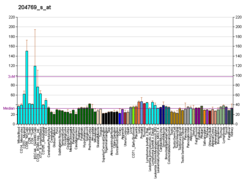TAP2 is a gene in humans that encodes the protein Antigen peptide transporter 2.[5][6][7]
- ^ a b c ENSG00000206299, ENSG00000228582, ENSG00000206235, ENSG00000225967, ENSG00000237599, ENSG00000223481, ENSG00000232326 GRCh38: Ensembl release 89: ENSG00000204267, ENSG00000206299, ENSG00000228582, ENSG00000206235, ENSG00000225967, ENSG00000237599, ENSG00000223481, ENSG00000232326 – Ensembl, May 2017
- ^ a b c GRCm38: Ensembl release 89: ENSMUSG00000024339 – Ensembl, May 2017
- ^ "Human PubMed Reference:". National Center for Biotechnology Information, U.S. National Library of Medicine.
- ^ "Mouse PubMed Reference:". National Center for Biotechnology Information, U.S. National Library of Medicine.
- ^ Bodmer JG, Marsh SG, Albert ED, Bodmer WF, Dupont B, Erlich HA, Mach B, Mayr WR, Parham P, Sasazuki T (Oct 1992). "Nomenclature for factors of the HLA system, 1991. WHO Nomenclature Committee for factors of the HLA system". Tissue Antigens. 39 (4): 161–73. doi:10.1111/j.1399-0039.1992.tb01932.x. PMID 1529427.
- ^ Bahram S, Arnold D, Bresnahan M, Strominger JL, Spies T (Dec 1991). "Two putative subunits of a peptide pump encoded in the human major histocompatibility complex class II region". Proc Natl Acad Sci U S A. 88 (22): 10094–8. Bibcode:1991PNAS...8810094B. doi:10.1073/pnas.88.22.10094. PMC 52874. PMID 1946428.
- ^ Hahn Y, Lee B (Feb 2006). "Human-specific nonsense mutations identified by genome sequence comparisons". Hum Genet. 119 (1–2): 169–78. doi:10.1007/s00439-005-0125-6. PMID 16395595. S2CID 21059468.






